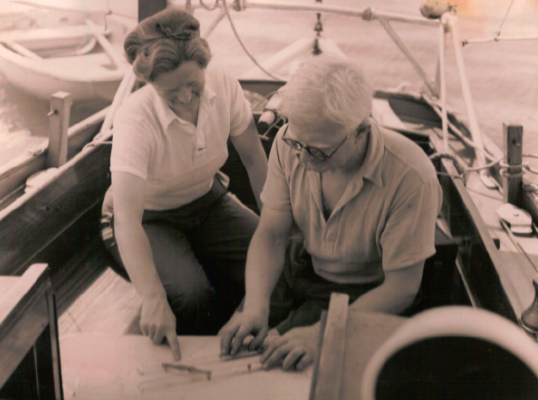Top 10 yacht pioneers
YBW's list of the top 10 yacht pioneers in the last 100 years. Who do you think should be on the list? We would love to hear your suggestions.
In no particular order, here is YBW’s list of the pioneers who had a huge impact on yachting over the last century.
From record breakers to those who inspired a generation of sailors, these are the men and women who showed incredible determination to achieve their goals.
Tweet us @ybw with your suggestions if your favourite pioneer isn’t on our list!
Éric Tabarly

Éric Tabarly, along with his series of Pen Duick yachts, dominated ocean racing for decades.
The French Naval officer’s original Pen Duick was the family-owned Yum, a William Fife designed gaff-rigged cutter.
Tabarly renamed and refitted the vessel, rebuilding Pen Duick with polyester resin during the 1950s.
But, it was his racing on the 44-foot Pen Duick II which gave Tabarly his legendary status.
In 1964, he took his custom-built light displacement ketch and entered it into the Observer Single-handed Transatlantic Race (OSTAR), beating the winner of the race’s first edition, and favourite- Sir Francis Chichester.
For beating the British at their own challenge, Tabarly was awarded France’s Legion D’Honneur. He also received the Blue Water Medal.
His victory in 27 days, 3 hours and 56 minutes led to the popularity of sailing in France. He also nurtured the likes of Alain Colas, Marc Pajot and Olivier de Kersauson, ensuring France’s racing legacy continued.
Success continued for Tarbarly, with wins in the Sydney Hobart and the Fastnet Race in 1967 on the aluminium Pen Duick III.
He took line honours in the 1969 Transpac on his trimaran, Pen Duick IV, as well as setting a new course record.
In 1976, he again won the OSTAR in his André Mauric designed 22-metre ketch, Pen Duick VI.
This edition of the race was particularly tough, with two major depressions forcing a record 50 retirements.
In 1980, he set the transatlantic sailing record from West to East (New York-The Lizard), on the multihull, Paul Ricard.
He did it in 10 days 5 hours 14 minutes and 20 seconds, beating the previous record which was set in 1905.
Tabarly raced in two Whitbread Round the World Races – the first edition in 1973 and in 1994.
In 1997, he won the Fastnet Race with Yves Parlier on Aquitaine Innovations.
Tabarly died in June 1998, when he was knocked overboard and drowned in the Irish Sea. He was sailing the original Pen Duick to Scotland as part of the boat’s centenary celebrations.
His home nation mourned, but his legacy has lived on. French skippers continue to dominate ocean racing today.
Vito Dumas
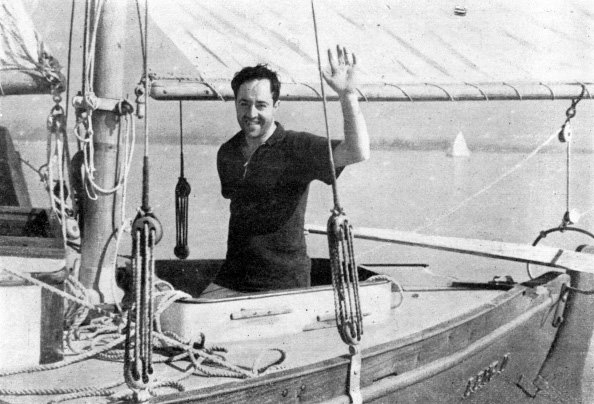
While nations battled in World War Two, Argentinian single-handed sailor, Vito Dumas set out to circumnavigate the Southern Ocean.
He left Buenos Aires in June 1942 on board his 32-foot Colin Archer ketch, LEHG II with only basic gear on board. He didn’t even have a radio because of fears he might be shot as a spy.
During the voyage through the “Roaring Forties”, he only made three landfalls at Cape Town, New Zealand and Valparaiso, Chile.
At times he was so cold, he had to stuff his clothes with newspaper to keep warm.
Dumas arrived back in Buenos Aires on 8 August 8 1943, 437 days after he set off.
Thousands turned out to greet the man who had become the first solo sailor to round Cape Horn and the first to sail around the world with only three landfalls.
Dumas wrote about the experience in his book Los Cuarenta Bramadores: La Vuelta al Mundo Por la “Ruta Imposible” (Alone Through The Roaring Forties).
Afterwards LEGH II was donated to the Argentine navy. It was later wrecked and then restored before being given to the Museo Naval de la Nacion (Naval Museum of the Nation) at Tigre.
Prior to his Southern Ocean adventure, Dumas had sailed, single-handed, from France to Argentina, in his 26-foot LEGH I, named using the initials of each of his four mistresses’ names at the time.
He left Arcachon in December 1931, arriving after 121 days at the Yacht Club Argentino in Buenos Aires.
The Argentinian skipper was also the first recipient of the Slocum Award in 1956, named in honour of Captain Joshua Slocum.
Dumas was given the award not only for his Southern Ocean feat and his 1931-2 single-handed voyage from France to Argentina, but for his single-handed voyage from Argentina to the United States of America via Bermuda in SIRO in 1956.
Dumas later received the Diploma of Merit of the Konex Awards from his home country. He died of a stroke in 1965.
His sailing legacy lives on through his books which include My Trips, Solo, toward the Southern Cross and The Cruise of the Unexpected.
Bernard Moitessier

The “free spirit” of sailing, Bernard Moitessier surprised some in the sailing community when he decided to quit the 1968-69 Sunday Times Golden Globe Race, despite being in front.
The Frenchman had the fastest circumnavigation time, but rather than continue back to England to fame and £5,000, he decided to continue sailing on his 39-foot ketch, Joshua.
He didn’t stop until June 1969 when he made landfall in Tahiti, setting the record for the longest nonstop passage by a yacht – 37,455 nautical miles in 10 months.
Moitessier later wrote about this experiences in La Longue Route; seul entre mers et ciels (The Long Way).
The book has become a classic, outlining Moitessier’s technique for heavy weather sailing.
Born and raised in Vietnam, Moitessier was already something of a sailing legend before the Golden Globe Race.
In 1966, he and his first wife, Françoise returned to France having initially set out with the intention of circumnavigating on Joshua.
Running out of time, Moitessier had decided to sail to France from Tahiti via Cape Horn, rather than taking the longer route via the Indian Ocean.
During this “logical route”, Moitessier drew heavily on the experiences and techniques of Argentinian sailor, Vito Dumas; he had a copy of Dumas’s book Los Cuarenta Bramadores: La Vuelta al Mundo Por la “Ruta Imposible” (Alone Through The Roaring Forties) on board.
When the couple arrived home they discovered, unintentionally, that they had completed the longest nonstop passage by a yacht in history—14,216 nautical miles, over 126 days.
Moitessier’s book, Cap Horn à la voile: 14216 milles sans escale (Cape Horn: The Logical Route) recounts the voyage and was, again, an instant success.
Moitessier continued travelling before he settled in Paris to write his autobiography, Voile, Mers Lointaines, Iles et Lagons (A Sea Vagabond’s World).
His earlier adventures on board his junk Marie-Thérèse and subsequent yacht, Marie-Thérèse II, which he sailed from Indonesia to the Caribbean, were recorded in Un Vagabond des mers du sud (Sailing to the Reefs). The book was published in 1960, and first brought Moitessier to the attention of the world’s sailing community.
He died in June 1994 and is buried in Bono in Brittany, France.
Sir Francis Chichester
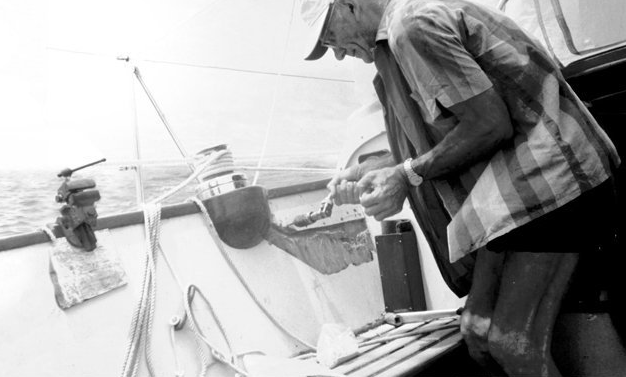
Sir Francis Chichester was already an acclaimed aviator and navigator when he made his mark on the sailing world.
The Devon-born sailor is best remembered for his 1966-67 circumnavigation on board his yawl, Gipsy Moth IV, for which he was knighted.
His long-distance sailing career began after his recovery from lung cancer, with the first Observer Single-handed Transatlantic Race (OSTAR) in 1960.
The revolutionary race was founded by Blondie Hassler.
Chichester entered and won in his 40-foot yacht, Gipsy Moth III, completing the route from Plymouth to New York City in 40 days, 12 hours and 30 minutes.
Four years later he came second, beaten by French skipper, Éric Tabarly.
Chichester then focussed on what was considered at the time an unimaginable feat of seamanship.
The 65-year-old skipper set sail from Plymouth in his Camper & Nicholson built Gipsy Moth IV to try and beat the passage times of the clipper ships.
He returned to Plymouth on 28 May 1967, having circumnavigated the globe, with one stop in Sydney, in 226 days.
Chichester became a hero – the first person to achieve a true circumnavigation of the world, solo, from West to East, via the great Capes.
The voyage captured the public’s imagination, and over 250,000 people turned out to see him arrive.
The event was globally televised, and Chichester, along with Gipsy Moth IV became famous around the world.
Chichester was knighted for his feat; the sword used in the ceremony had belonged to Sir Francis Drake, himself a notable sea captain and navigator who carried out the second ever circumnavigation around the world.
Chichester was also put on the newly issued 1/9d stamp, the first living non-royal to appear on one.
Two years after his circumnavigation, Chichester, in Gipsy Moth V attempted to sail 4,000 miles in 20 days, but failed by one day.
He died in Plymouth in August 1972, but left a body of work including Gipsy Moth Circles the World, Alone Across the Atlantic and The Romantic Challenge.
Gipsy Moth IV, after decades of neglect, was eventually restored following a campaign by Yachting Monthly and the United Kingdom Sailing Academy.
It went on to circumnavigate the world again via the trade wind route and the Panama and Suez Canals, arriving back in Plymouth on 28 May 2007.
James Wharram

James Wharram is considered the inventor of the modern day catamaran.
Using his research into ancient Polynesian boat design, he designed and built the first offshore catamaran in Britain, the 23-foot Tangaroa.
At the time, many in the global yachting community dismissed the idea that such a design could be seaworthy.
But Wharram, who was inspired by the journey of Frenchman Eric de Bisschop, who sailed a double canoe from Hawaii to France in 1939, proved them wrong.
In 1955-56, he sailed his “double hulled canoe” from Falmouth, Cornwall to the West Indies with two German girls, Ruth Merseburger (later Wharram) and Jutta Schultze-Rohnhof.
In Trinidad, he built the second 40-foot Polynesia style catamaran, Rongo, with the help of Bernard Moitessier and his friend, Harry Wakelam.
Wharram, Merseburger and Schultze-Rohnhof then continued their voyage, sailing from Trinidad to New York, and then across the Atlantic to Ireland.
They were the first to sail a catamaran west to east across the North Atlantic.
This, and the subsequent book, Two Girls, Two Catamarans, secured Wharram’s place in yachting history.
Wharram, who is now 88, is still designing, building and sailing offshore catamarans from his base in Devoran, Cornwall.
He is one of the most successful multihull designers in the world, having sold more than 10,000 plans for his Wharram self-build catamarans. Ruth Wharram was also a key part of the design team.
He has worked closely with his co-designer Hanneke Boon, creating new building methods such as the lashed crossbeam connections and the Wharram Wingsail Rig.
In 1994-98, Wharram and his partners sailed their flagship, the 63-foot catamaran, Spirit of Gaia into the Pacific and round the world.
Their voyage was to study Indo-Pacific canoe design. Spirit of Gaia is currently being renovated in Greece.
In 2008-9, 50 years after his pioneering Trans-Atlantic crossings, Wharram and Boon sailed in the Lapita Voyage expedition.
The trip, which was conceived by them and the German maritime author, Klaus Hympendahl, followed the ancient migration route into the Pacific.
In two Tama Moana double canoes, designed by Wharram, the crew sailed around 4,000 nautical miles from the Philippines to Tikopia and Anuta in the Solomon Islands.
The boats were subsequently donated to the islands for future transport use.
The voyage was compared to Thor Heyerdahl’s voyage of the Kon-Tiki, in which the Norwegian attempted to prove the Polynesians migrated into the Pacific from South America.
Eric & Susan Hiscock

Few sailors start ocean cruising without at least one of Eric Hiscock’s books on board.
Together with his crew, wife Susan, he chronicled his sailing adventures and wrote technical books including Cruising Under Sail and Voyaging Under Sail.
Hiscock and his wife were one of the few people in the 1950s cruising the world for pleasure on small sail boats.
They were the world’s most famous cruising couple of their day.
Their first circumnavigation was on board the now legendary Wanderer III between 1952-1955.
The subsequent book, Around the World in Wanderer III, was popular, and sparked a series of books about their later voyages on board the 30 foot Laurant Giles sloop, as well as their other vessels Wanderer IV and Wanderer V.
Hiscock was the first recipient of the Yachtsman of the Year award in 1955.
He was presented with the ‘Knighthood of Yachting’ for his three-year circumnavigation with Susan in Wanderer III.
This sloop is the only vessel to have won America’s Blue Water Medal under both sets of owners.
It is presented for “meritorious seamanship and adventure upon the sea displayed by amateur sailors of all nationalities, that might otherwise go unrecognized.”
Hiscock died on board Wanderer V in Whangarei, New Zealand in 1986.
Susan Hiscock continued for several years sailing solo in Wanderer V before returning to Yarmouth, Isle of Wight.
She bought an 11-foot scow, and apparently won her first-ever race at Yarmouth Sailing Club, aged 80. Susan died in 1995.
Tracy Edwards
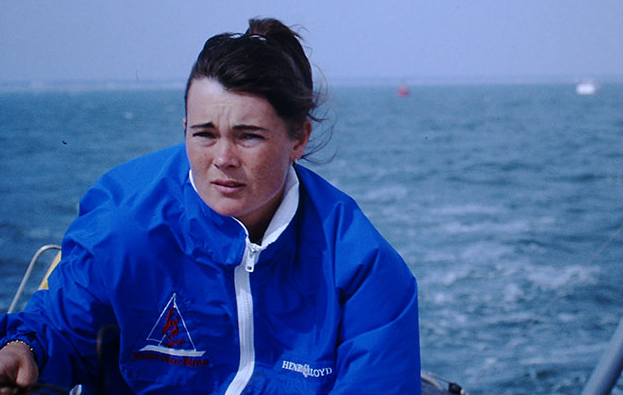
A trailblazer for women sailors, Tracy Edwards skippered the first all-female crew in the 1989-90 Whitbread Round the World Yacht Race.
Her 12 crew on board the 58-foot yacht, Maiden defied the critics by winning two legs and finishing second in its class, the best performances in the race by a British boat since 1977.
Edwards had never really sailed until she landed a job as a stewardess on board a motor yacht in Greece when she was 16.
Her boyfriend had taken part in a Whitbread race which inspired her to do the same.
She initially sailed on Norsk Data GB before joining the crew of the Atlantic Privateer for the 1985-86 Whitbread – the only woman on board.
Edwards realised that of the 200 crew members in the race, only five were women. This inspired her, at the age of 27, to enter the Maiden crew for the 1989-90 Whitbread, despite the hostility she received.
She was awarded an MBE and became the first woman to be voted ‘Yachtsman of the Year’ by the Yachting Journalists’ Association.
In 1998 Edwards assembled an all-female crew for the 1998 Jules Verne trophy.
The crew were on course to break the record for the fastest circumnavigation of the world with no stopping and no outside assistance when they hit storms off the coast of Chile.
The mast of their 92 foot catamaran, Royal and SunAlliance, broke in the storm ending their attempt. It took the crew 16 days to reach the shore, and Edwards has said that she will always be proud that they didn’t need rescuing.
Edwards has since retired from sailing and is now a motivational speaker.
She launched a campaign to save Maiden in 2006 after discovering it was rotting in a marina in the Indian Ocean.
It has been restored in Cape Town, South Africa, and fundraising is underway to bring the yacht back to the UK.
Sir Robin Knox-Johnston
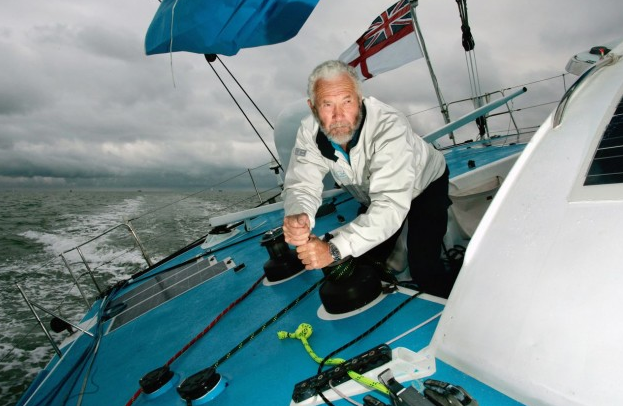
A legend in his own lifetime, Sir Robin Knox-Johnston first shot to fame after he became the first person to sail single handed and non-stop around the world.
He was the only entrant in the Sunday Times Golden Globe Race to complete the challenge on 22 April 1969 on board his 32-foot Bermuda ketch, Suhaili.
In recognition of his achievement, he was created a Commander of the Most Excellent Order of the British Empire (CBE).
A former Merchant Navy officer, Knox-Johnston, had previously sailed Suhaili from Bombay, India to the UK via Arabia and the Cape of Good Hope in 1965-7.
In 1969, Knox-Johnston and Leslie Williams bought the 71-foot ketch, Ocean Spirit. At the time, the Ocean 71 hull was the largest GRP boat ever moulded.
They entered the 1970 Round Britain Race and won it by two days – the only time the race has been won by a monohull.
Knox-Johnston repeated this success in 1974, this time with Gerry Boxall on the Rod Macalpine-Downie designed catamaran, British Oxygen.
Ocean Spirit, crewed by Knox-Johnston, Williams and the late Sir Peter Blake, went on to take line honours in the inaugural Cape Town to Rio Race in 1971.
Knox-Johnston, Williams and Blake reunited again for the 1977-78 Whitbread Round the World Race.
Knox-Johnston skippered the 77-foot, John Sharp-designed maxi sloop, Condor to line honours in two legs. Blake would later win the 1989–90 Whitbread race, skippering Steinlager 2 to an unprecedented clean sweep of line, handicap and overall honours on each of the race’s six legs.
In 1994, Knox-Johnston and Blake co-skippered the remodelled Nigel Irens designed catamaran, Enza New Zealand to take the Jules Verne Trophy for the fastest circumnavigation of the world.
They did it in 74 days 22 hours 18 minutes, and set a new world record.
In 1995, Knox-Johnston was knighted, and the following year established the Clipper Around the World Yacht race, opening the sport to novice sailors.
In 2006/07, to prove that age was no barrier, Knox-Johnston entered the VELUX 5 Ocean Race. At 68, he was the oldest competitor in the race.
On 4 May 2007, he defied the critics by completing his second solo circumnavigation of the world in the Open 60 Fila, SAGA Insurance. Overall, he finished 4th place in the VELUX.
Over the last five decades, Knox-Johnston has been honoured for his contribution to global sailing and racing.
He has been named UK Yachtsman of the Year four times.
In 2010, he was awarded the Cruising Club of America’s Blue Water Medal for the advancement of sailing, sail training and youth development.
Knox-Johnson has also received the Royal Cruising Club Seamanship Medal, Silk Cut Nautical award Seamanship Trophy, the Royal Institute of Navigation’s Gold Medal for experiments with renaissance navigation and The Maritime Trust’s Cutty Sark Medal, to name just a few.
On 1994, the ISAF named him as World Sailor of the Year, and in 2008 he entered the ISAF Hall of Fame.
He is also a past president of the Sail Training Association, has been elected a Younger Brother of Trinity House, is a Freeman of the City of London and was elected president of the Little Ship Club in 1995.
Dame Naomi James
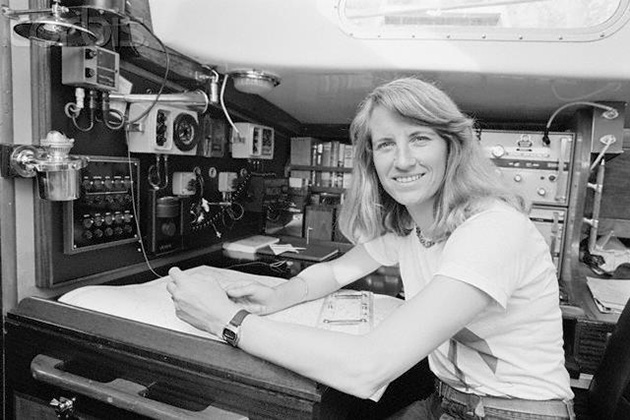
Dame Naomi James made history on the 8 June 1978, when she sailed into Dartmouth on board her storm-battered sloop, Express Crusader.
Not only was she the first woman to have sailed single-handed around the world via Cape Horn, but she had also done it in 272 days.
This beat Sir Francis Chichester’s round-the-world sailing record by two days.
Quite a feat for the 29-year-old who had only learnt to sail three years earlier, and had only learnt to swim at the age of 23.
James was initially an unlikely sailor, growing up on a sheep farm in New Zealand.
She decided to sail to Europe in search of adventure and in St Malo, France in the summer of 1975 met her future husband Rob James. At the time he was skippering yachts for Chay Blyth.
As their relationship blossomed, so did James’ sea legs and she decided, with the backing of her husband, to attempt the circumnavigation.
Blyth even lent her his boat, the Spirit of Cutty Sark, which was later renamed Express Crusader.
In later interviews, James admitted her sailing skills were far from perfect, but she pushed on, even when faced with damage to her yacht’s rigging and a knockdown in a storm.
Dame Naomi and her husband went on to win the 1982 Around Britain Race on board their catamaran, Colt Cars. She hasn’t sailed since.
In March 1983, Rob James, 36, died in Salcombe Harbour when he fell into the sea from Colt Cars. He had been moving the boat from Cowes to Salcombe.
Dame Naomi currently lives in Ireland and has written several books including At One with the Sea: Alone Around The World and At Sea on Land.
David Lewis

At the age of 55, Dr David Lewis set sail on his 32 foot steel cutter, Ice Bird with the aim of circumnavigating the Antarctic continent.
At the time, no one was known to have sailed solo to Antarctica.
He left Sydney, Australia on 19 October 1972.
Just over 14 weeks later, Lewis, with frost-bitten hands and a nearly wrecked Ice Bird, limped into the American Antarctic base.
Lewis had capsized three times and been dismasted twice in hurricane-force storms. He had sailed the last 2,500 nautical miles under jury rig.
He described the incredible voyage in his memoirs, Shapes of the Wind – a fascinating account of a sailor pushed to the very edge of endurance in some of the most inhospitable seas on earth.
Lewis, who was born in Plymouth, never completed his circumnavigation of the continent.
He left Ice Bird at Palmer while he accepted an invitation from National Geographic to write about his expertise ancient Polynesian navigation.
In his absence, Ice Bird has been repaired and eight months later he set sail from Palmer station, getting caught in a heavy ice field. After again capsizing, he abandoned the voyage and made landfall in Cape Town.
His book, Ice Bird, recounts the vessel’s trip. Ice Bird was eventually sailed back to Sydney and was donated to the Powerhouse Museum.
Lewis’ studies on the traditional systems of navigation used by the Polynesians was one of his lasting legacies, and are documented in his book, We, the Navigators.
He used these methods while sailing around the world on Rehu Moana with this family in the 1960s. This was the first catamaran to complete a circumnavigation of the world.
Lewis was also one of the skippers to enter the first Observer Single-handed Transatlantic Race (OSTAR) in 1960, which was won by Sir Francis Chichester.
He came third after repairs to Cardinal Vertue lost him two days of racing, which are recounted in the book, The Ship Would Not Sail Due West.
Lewis received many awards. These included Australian Geographic magazine’s Adventurer of the Year in 1998, the Gold Medal of the Royal Institute of Navigation and the Bernard Fergusson Trophy as New Zealand’s Yachtsman of the Year 1965.
He died in Queensland in October 2002.









